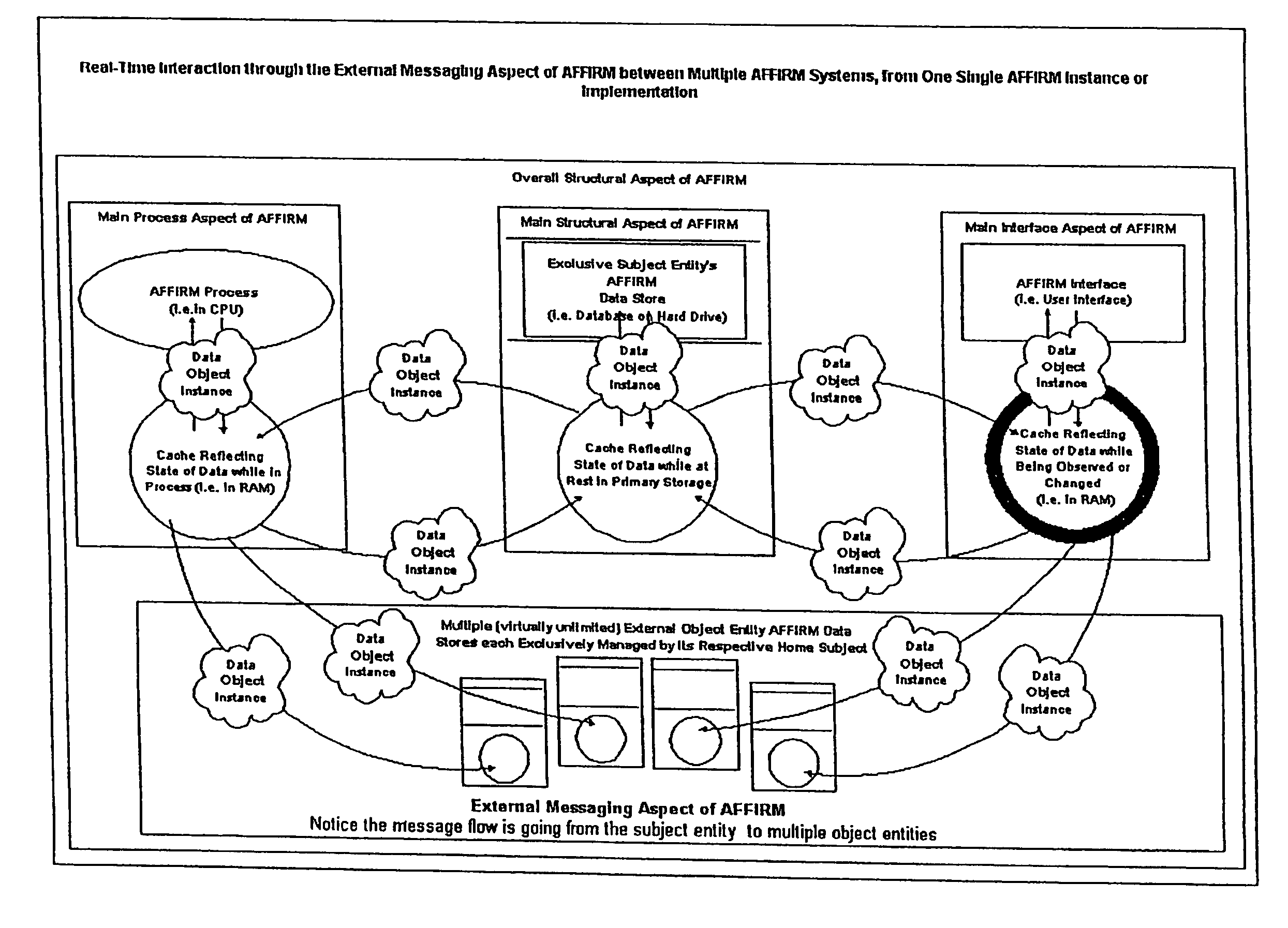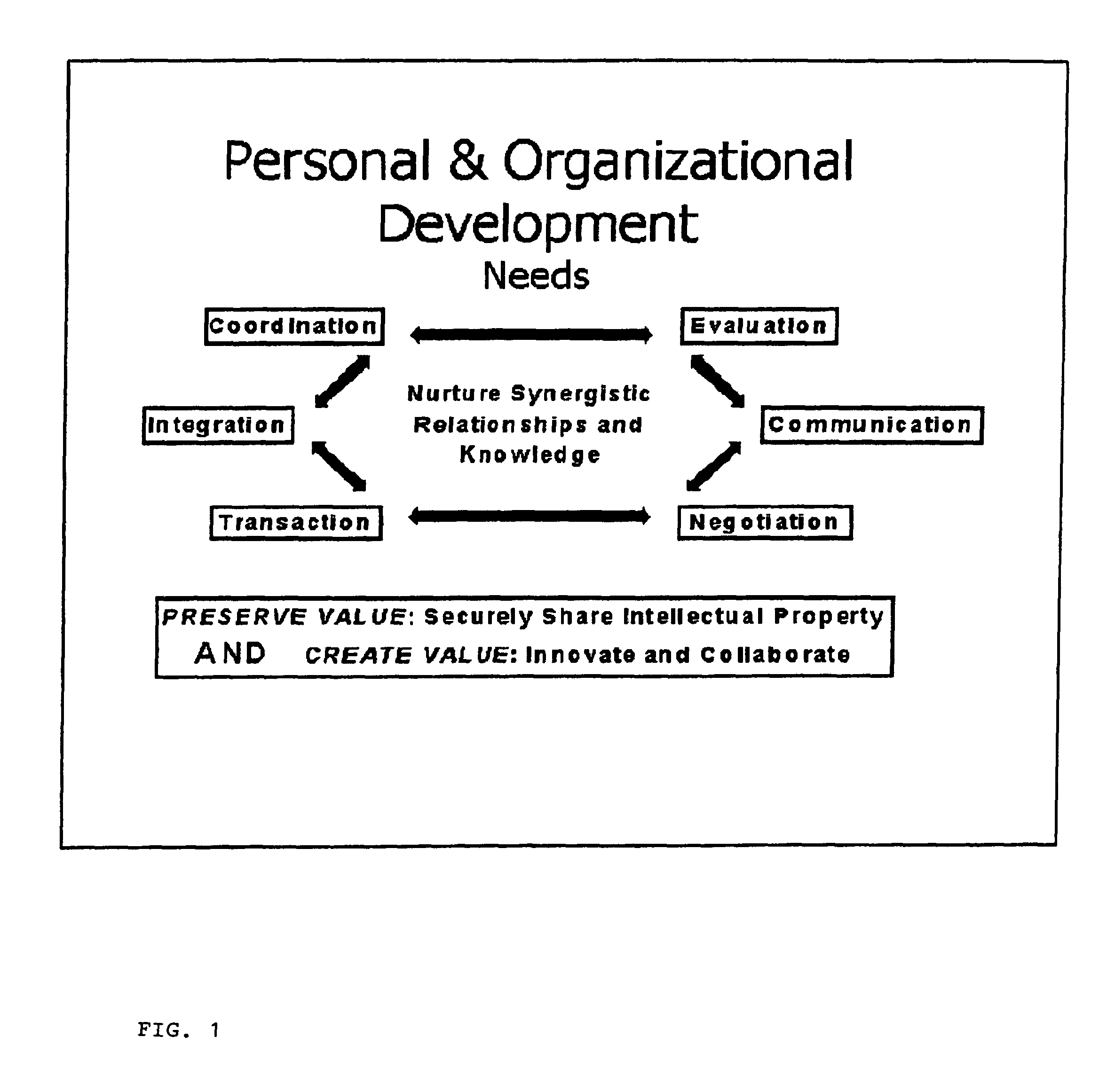Also, as one can readily imagine after experiencing contemporary science fiction, there are also potential threats from intelligent machines getting out of control.
Current technology is not very good at helping achieve either of these two primary objectives, securing existing value and creating new value.
Previous attempts to satisfy these needs electronically have been less than ideal because of security limitations and impractical and costly integration requirements of systems from the following categories: Analytical Applications—data warehousing, decision support, performance management applications often categorized and on-line analytical
processing (OLAP); and
Collaboration Tools—office, email,
instant messaging, whiteboards, team sites, etc; Transactional Applications—ERP, accounting,
inventory management,
purchasing, sales, etc., often referred to as on-line transactional
processing (OLTP).
Given these present limits, these systems are unable to provide the above mentioned
value creation capabilities in a practical way.
Most of today's Web servers are merely haphazard additions to a company's
information technology infrastructure.
In fact, this absence of integration is also true of most company's internal transactional, decision support and / or
data warehouse systems.
Frankly, it is an embarrassing situation for the designers of today's systems.
This prevailing situation was acceptable when
online business was in its early stages and businesses were not required to be proactive, but now, as e-business is advancing into a more
collaborative knowledge-based commerce stage, this
integration problem is a major detriment to further growth and development.
Therefore, the status quo will become unacceptable, and the companies that break away from these severe limitations will enjoy huge gains in competitive position.
At this time, satisfactory solutions do not exist for this challenging problem.
Today's “computerized application programs” do not efficiently and effectively structure data about an individual's behavior and ever-changing status vis-à-vis their environment.
But unfortunately these programs
record data of specific types in specific pre-defined
database “Tables”.
Therefore, these programs are not good at handling an end-user's evolving
data type requirements for previously unspecified processes or situations.
Since
database application programs, e.g. accounting systems, are structured to
handle only specific numbers and / or types of data “Tables” and / or “Fields”, they are not able to productively communicate with other application programs designed to
handle different types of data.
Therefore, different systems handling different types of data do not effectively and / or directly interact with each other.
Because of the difficulty in current disparate systems interacting, most business expenditures in
information technology are for training and / or integration of different systems, rather than for the acquisition of new systems.
The problem with this is that industry groups can't agree on standard or common schemas that define everyone's needs.
To get organizations in multiple industries to agree on standards, so that better convergence could be achieved, would be even more challenging.
Therefore, fluidly communicating structured data between organizations and their servers continues to be a major problem.
Another different problem is that it is difficult to manage the security of structured data in today's application programs or services.
It is very difficult to keep information private once it is placed on a
networked system.
Just the fact that private information for more that one individual is store in a common place makes the information vulnerable to access by unintended parties.
As a result of these limitations and difficulties with current information technology, an individual (i.e.
individual person, group, organization or other entity) still does not have access to cost effective and secure computerized services that effectively guide, coordinate and assist in the management of common yet ever changing processes.
In addition to having too many of these above mentioned unnecessary and costly requirements with today's systems there are also some potentially valuable things that current systems, no matter how expensive they are, cannot do.
Unfortunately this is not possible when different groups in different domains are used to naturally building their own vocabularies.
This makes it difficult for different groups using different vocabularies to communicate or collaborate. e.g. nano, bio, info and cogno scientists all have different words for what they call the connections between the components of their structures.
It must be very difficult to thoroughly research all the different patents that might be related to a new
patent application, given this common tendency of different individuals from different or even related domains using different words to describe the same thing.
As a result of this standard
programming paradigm, specific “Tables or “Classes” only handling specific types of data or objects, if an end-user wants an existing application to
handle a new and different type of data or object, they will find that it won't work.
They are stuck or rendered helpless unless they find a different program to handle their new type of data or object or they need to expend effort “
programming” their own application program that will most likely not interoperate with the other existing programs.
Since these capabilities have not previously existed, the coordinated development of “
business process applications” that supported
collaborative interaction and evolved in real-time could not be created and / or not be programmed by normal businesspeople or “end-users”.
This causes problems trying to get data from the transactional systems, usually the source applications, to analytical systems.
Because of the extraction, transformation and load (ETL) procedures that are usually necessary before data gets to analytical systems, there is normally a time
delay that prevents real-
time data analysis.
Another problem resulting from the fact that OLTP and OLAP systems are usually separate “islands” or “silos” that don't integrate very well is that this makes it difficult for an organizations learning loop to be a complete and fluid circuit.
Unfortunately, because of the disjointedness of these two types of systems, they do not effectively support organizational learning.
As a result, users of both types of systems can suffer from
slow response times. Therefore we need better ways to distribute data and
processing across multiple computers.
But unfortunately current OLTP technology used for managing inventory, financial accounts and other important resources are not good at coordinating interaction between multiple parties and resources without bringing the data for these together in one common central location.
Again this causes information systems to have inherent security and performance problems.
OLTP systems that involve more multi-user writing of data than OLAP systems also suffer from other difficulties.
Also, when computer servers are connected directly or indirectly to a network and allow access by the public or unknown users, e.g. email and web servers, they are subject to the possibility that these unknown users will purposely or un-purposely use too many resources from the
server.
It would be better if these servers could not be accessed by unknown parties, but given the way email and other servers work, this is unpractical.
This could cause abuse of power and / or subject the network to severe
vulnerability.
For security reasons operating systems are not supposed to allow their users to work with file systems on other computers on a network from a
web browser.
It would be particularly stunting of progress toward systems that enable computers to improve the
quality of life and productivity of humans, if there was only one company that could compete in the market for business applications.
But unfortunately “all channel” networks make it difficult for leaders to emerge and current “all channel” communication technologies do not support storage and communication of structured data as is needed to support in-line analysis, transactions and synthesis between entities.
Email systems are also prone to viruses and other attacks.
Another “all channel” communication technology called
instant messaging is designed for users to be synchronously (at the same time) connected, and is also not designed for storing and communicating structured data.
Again, current “all channel” systems are either requiring fixed formats or
data type definitions, like EDI, or are like email and
instant messaging and are not designed to handle structured data.
Current databases and spreadsheets handle structured data, but do not handle the ability to flexibly coordinate the integration or synthesis of the structured data between disparate hubs.
These distribution systems, especially the peer-to-peer type, are not able to efficiently and effectively prevent unauthorized
copying and distribution of this digitally recorded content.
All together these above problems and limitations of current CIT enable thieves to steal ones identity and digital assets in cyberspace and cause major problems for the individual victim.
Computers on the other hand, and their “programmers” that are not usually experienced or trained as business persons, are not usually as good at judging what would be the right thing to do at a particular time.
Unfortunately, there almost always seems to be something lost in translation.
Computers just do what they are specifically told to do, and at this point in time it is still too difficult to tell computers what to do.
This does not ideally support dynamic situations where business users need real-time transactional and analytical processing systems that can easily adapt to
user needs, communicate and share structured data with users and systems with different
data type definitions.
One reason we don't have computers that are able to do these things very well is because computers are not currently capable of being conscious or understanding of the intimate details about relationships between entities.
Up to this point it hasn't been done very well.
And this is one reason why CIT systems are not as good at assisting in the management of relationships as they could be.
 Login to View More
Login to View More  Login to View More
Login to View More 


